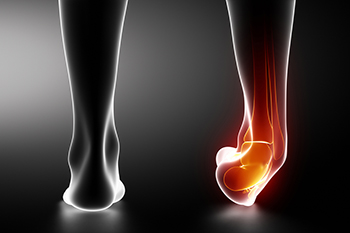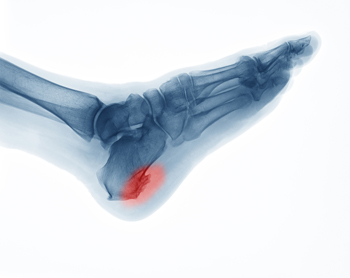Connect With Us
Blog
Items filtered by date: February 2022
Plantar Warts Can Be Treated!
Heel Spurs: The Body’s Response to Stress on Ligaments and Tendons
A heel spur is a pointy accumulation of calcium deposits that build up over time on the heel bone. They are the body’s response to repetitive strain or localized inflammation where soft tissues meet the bone. Heel spurs can develop at various locations on the heel bone. When the Achilles tendon becomes inflamed, a heel spur can sometimes develop at the back of the heel (where the tendon attaches to the bone). When the long tissue that connects the toes with the heel (plantar fascia) becomes damaged and inflamed, heel spurs can sometimes form on the heel under the arch. Obesity, gait abnormalities, flat feet or high arches, age, improperly fitted shoes, and other factors that stress the feet can also contribute to the formation of a heel spur. Some heel spurs can cause pain and tenderness, while others are asymptomatic, and only become discovered on an X-ray taken to diagnose another condition. A podiatrist can treat a heel spur through a variety of conservative treatments including icing and resting, physical therapy, stretching, oral or injectable anti-inflammatory medications, and custom orthotic devices.
Heel spurs can be incredibly painful and sometimes may make you unable to participate in physical activities. To get medical care for your heel spurs, contact one of our podiatrists from New England Foot and Ankle. Our doctors will do everything possible to treat your condition.
Heels Spurs
Heel spurs are formed by calcium deposits on the back of the foot where the heel is. This can also be caused by small fragments of bone breaking off one section of the foot, attaching onto the back of the foot. Heel spurs can also be bone growth on the back of the foot and may grow in the direction of the arch of the foot.
Older individuals usually suffer from heel spurs and pain sometimes intensifies with age. One of the main condition's spurs are related to is plantar fasciitis.
Pain
The pain associated with spurs is often because of weight placed on the feet. When someone is walking, their entire weight is concentrated on the feet. Bone spurs then have the tendency to affect other bones and tissues around the foot. As the pain continues, the feet will become tender and sensitive over time.
Treatments
There are many ways to treat heel spurs. If one is suffering from heel spurs in conjunction with pain, there are several methods for healing. Medication, surgery, and herbal care are some options.
If you have any questions feel free to contact one of our offices located in Chelmsford and Newburyport, MA . We offer the latest in diagnostic and treatment technology to meet your needs.
Why Laser Treatment for Fungal Nails Can Be Effective
Fungal infections of the toenail (onychomycosis) can cause nails to thicken, turn yellow, and possibly separate from the nail bed. Onychomycosis can be very stubborn and difficult to treat. This is because the nail grows so slowly, and fungus gets in between the multiple layers making up the nail, under the nail, or even in the nail matrix. Laser treatment for fungal nails is believed to be an effective and safe treatment for the eradication of onychomycosis. This is because the laser can penetrate the nail and be precisely targeted to attack the fungus without damaging surrounding skin or tissue. Laser treatment for fungal nails can take as little as one treatment and prevent the infection from spreading or returning. If you have developed a fungal toenail infection, ask your podiatrist if laser treatment is right for you.
Laser treatment can be an effective way to get rid of toenail fungus. If you have any questions about laser treatment, consult with one of our podiatrists from New England Foot and Ankle. Our doctors will assess your condition and provide you with quality treatment for fungal nails.
What Are Toenail Fungal Infections?
Onychomycosis, or fungal infection of the nail, is a relatively common and non-serious condition. Around 10 percent of U.S. citizens are afflicted with fungal nails. Common forms of fungus that infect the nail include dermatophytes, yeasts, and molds.
Symptoms of Toenail Fungal Infections Include:
- Nail thickening
- Brittleness of the nail
- Discoloration of the nail
Diagnosis for Fungal Nails
Fungal infections are diagnosed by fungal culture and microscopy. This will rule out any other conditions such as nail trauma, psoriasis, lichen planus, and onychogryphosis.
What Is Laser Treatment?
Laser treatment is a non-invasive, safe, quick, and painless procedure that uses the heat from a laser to kill fungus in the nail. Each infected nail is targeted with a laser for several minutes. The treatment is usually utilized several different times over a select period. During this time, a podiatrist will keep an eye on the infection.
If you have any questions, please feel free to contact one of our offices located in Chelmsford and Newburyport, MA . We offer the newest diagnostic and treatment technologies for all your foot care needs.
How to Know if You Should Visit a Podiatrist
 There are a variety of issues and injuries that can result in pain, swelling or stiffness to the feet and ankles, including trauma or just simple wear and tear on the body. While staying active is the best way to help keep your feet in shape, there are signs to look for that may indicate the care of a podiatrist is necessary. Anyone who has experienced significant trauma to a foot or ankle from a fall or direct injury would be wise to have the injured area examined by a professional as soon as possible. Further, if you notice that your feet or ankles are misshapen, have a hot or tender feeling, constantly hurt, or are unable to bear weight, it is suggested that you consult a podiatrist to find the source of the issue. Once a diagnosis is made, a podiatrist will be able to help provide a proper treatment plan.
There are a variety of issues and injuries that can result in pain, swelling or stiffness to the feet and ankles, including trauma or just simple wear and tear on the body. While staying active is the best way to help keep your feet in shape, there are signs to look for that may indicate the care of a podiatrist is necessary. Anyone who has experienced significant trauma to a foot or ankle from a fall or direct injury would be wise to have the injured area examined by a professional as soon as possible. Further, if you notice that your feet or ankles are misshapen, have a hot or tender feeling, constantly hurt, or are unable to bear weight, it is suggested that you consult a podiatrist to find the source of the issue. Once a diagnosis is made, a podiatrist will be able to help provide a proper treatment plan.
Foot and ankle trauma is common among athletes and the elderly. If you have concerns that you may have experienced trauma to the foot and ankle, consult with one of our podiatrists from New England Foot and Ankle. Our doctors will assess your condition and provide you with quality foot and ankle treatment.
Foot and ankle trauma cover a range of injuries all over the foot; common injuries include:
- Broken bones
- Muscle strains
- Injuries to the tendons and ligaments
- Stress fractures
Symptoms
Symptoms of foot and ankle injuries vary depending on the injury, but more common ones include:
- Bruising
- Inflammation/ Swelling
- Pain
Diagnosis
To properly diagnose the exact type of injury, podiatrists will conduct a number of different tests. Some of these include sensation and visual tests, X-rays, and MRIs. Medical and family histories will also be taken into account.
Treatment
Once the injury has been diagnosed, the podiatrist can than offer the best treatment options for you. In less severe cases, rest and keeping pressure off the foot may be all that’s necessary. Orthotics, such as a specially made shoes, or immobilization devices, like splints or casts, may be deemed necessary. Finally, if the injury is severe enough, surgery may be necessary.
If you have any questions, please feel free to contact one of our offices located in Chelmsford and Newburyport, MA . We offer the newest diagnostic and treatment technologies for all your foot care needs.
Arthritis Can Cause Pain in the Feet and Ankles
How Ankle Sprains Occur
 Ankle sprains result when the ligaments, which connect the bones to each other, get overstretched or torn. Common signs of an ankle sprain include a “snap” or “crack” sound at the moment of injury. Sprains can also lead to bruising, swelling, and difficulty bearing weight. Ankle sprains usually result from the ankle getting twisted or rolled, and are one of the most common injuries that athletes deal with. Sports like soccer, football, and basketball that require a variety of quick movements leave players at a higher risk for ankle sprains. Athletes who have previously sprained an ankle are at a greater risk of re-spraining it. Patients who believe that they have sprained their ankle may wish to consult with a podiatrist for a proper diagnosis, because the symptoms of an ankle sprain and a fracture can be similar.
Ankle sprains result when the ligaments, which connect the bones to each other, get overstretched or torn. Common signs of an ankle sprain include a “snap” or “crack” sound at the moment of injury. Sprains can also lead to bruising, swelling, and difficulty bearing weight. Ankle sprains usually result from the ankle getting twisted or rolled, and are one of the most common injuries that athletes deal with. Sports like soccer, football, and basketball that require a variety of quick movements leave players at a higher risk for ankle sprains. Athletes who have previously sprained an ankle are at a greater risk of re-spraining it. Patients who believe that they have sprained their ankle may wish to consult with a podiatrist for a proper diagnosis, because the symptoms of an ankle sprain and a fracture can be similar.
Ankle sprains are common but need immediate attention. If you need your feet checked, contact one of our podiatrists from New England Foot and Ankle. Our doctors can provide the care you need to keep you pain-free and on your feet.
How Does an Ankle Sprain Occur?
Ankle sprains take place when the ligaments in your ankle are torn or stretched beyond their limits. There are multiple ways that the ankle can become injured, including twisting or rolling over onto your ankle, putting undue stress on it, or causing trauma to the ankle itself.
What Are the Symptoms?
- Mild to moderate bruising
- Limited mobility
- Swelling
- Discoloration of the skin (depending on severity)
Preventing a Sprain
- Wearing appropriate shoes for the occasion
- Stretching before exercises and sports
- Knowing your limits
Treatment of a Sprain
Treatment of a sprain depends on the severity. Many times, people are told to rest and remain off their feet completely, while others are given an air cast. If the sprain is very severe, surgery may be required.
If you have suffered an ankle sprain previously, you may want to consider additional support such as a brace and regular exercises to strengthen the ankle.
If you have any questions please feel free to contact one of our offices located in Chelmsford and Newburyport, MA . We offer the newest diagnostic and treatment technologies for all your foot and ankle needs.
Blog Archives
- April 2025
- March 2025
- February 2025
- January 2025
- December 2024
- November 2024
- October 2024
- September 2024
- August 2024
- July 2024
- June 2024
- May 2024
- April 2024
- March 2024
- February 2024
- January 2024
- December 2023
- November 2023
- October 2023
- September 2023
- August 2023
- July 2023
- June 2023
- May 2023
- April 2023
- March 2023
- February 2023
- January 2023
- December 2022
- November 2022
- October 2022
- September 2022
- August 2022
- July 2022
- June 2022
- May 2022
- April 2022
- March 2022
- February 2022
- January 2022
- December 2021
- November 2021
- October 2021
- September 2021
- August 2021
- July 2021
- June 2021
- May 2021
- April 2021
- March 2021
- February 2021
- January 2021
- December 2020
- November 2020
- October 2020
- September 2020
- August 2020
- July 2020
- June 2020
- May 2020
- April 2020
- March 2020
- February 2020
- January 2020
- December 2019
- November 2019
- October 2019
- September 2019
- August 2019
- July 2019
- June 2019
- May 2019
- April 2019
- March 2019
- February 2019
- January 2019
- December 2018
- November 2018
- October 2018
- September 2018
- August 2018
- July 2018
- June 2018
- May 2018
- April 2018
- March 2018
- February 2018
- January 2018
- December 2017
- November 2017
- October 2017
- September 2017
- August 2017
- July 2017
- June 2017
- May 2017
- April 2017
- March 2017
- February 2017
- March 2016




